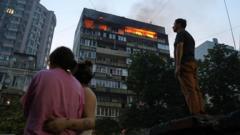As tensions escalate in the ongoing conflict, Greenpeace has reported that satellite images suggest Russian officials are constructing power lines to connect the Zaporizhzhia nuclear plant to their energy grid.
Satellite Evidence Reveals Russia's Nuclear Ambitions in Occupied Ukraine

Satellite Evidence Reveals Russia's Nuclear Ambitions in Occupied Ukraine
Recent satellite findings indicate Russia's attempt to reactivate a seized nuclear plant in Ukraine, raising significant safety concerns.
Despite heightened risks of nuclear disaster amid ongoing military activities, Moscow continues to pursue plans to restart the facility, which has remained offline since it was captured early in the conflict. The Zaporizhzhia nuclear power plant, located in southeastern Ukraine, has been a point of concern due to fears that its proximity to active combat zones could lead to catastrophic consequences if mishandled.
In a detailed report shared with The New York Times, Greenpeace highlighted that satellite images from early February indicate that Russia has constructed over 50 miles of electricity transmission lines and related infrastructure between the occupied cities of Mariupol and Berdyansk, both situated along the Azov Sea coastline. These developments represent the first tangible evidence of Moscow's intentions to operationalize the nuclear facility despite international condemnation of their seizure.
According to Shaun Burnie, a nuclear specialist at Greenpeace Ukraine, this strategic move appears to be a crucial step in Russia's plans to resume operations at the Zaporizhzhia plant. Burnie emphasized the necessity of establishing new electricity transmission lines for this initiative, implying that further construction is likely required to integrate the nuclear facility with Russia’s grid effectively.
While the precise nature of Moscow's long-term plans for the nuclear plant remains ambiguous, speculation has arisen regarding whether they aim to manage the facility in a post-conflict scenario or during ongoing hostilities. Experts affirm that additional infrastructure will be vital for connecting the plant to Russia's energy network, a demanding endeavor that could consume substantial time and resources.
In a detailed report shared with The New York Times, Greenpeace highlighted that satellite images from early February indicate that Russia has constructed over 50 miles of electricity transmission lines and related infrastructure between the occupied cities of Mariupol and Berdyansk, both situated along the Azov Sea coastline. These developments represent the first tangible evidence of Moscow's intentions to operationalize the nuclear facility despite international condemnation of their seizure.
According to Shaun Burnie, a nuclear specialist at Greenpeace Ukraine, this strategic move appears to be a crucial step in Russia's plans to resume operations at the Zaporizhzhia plant. Burnie emphasized the necessity of establishing new electricity transmission lines for this initiative, implying that further construction is likely required to integrate the nuclear facility with Russia’s grid effectively.
While the precise nature of Moscow's long-term plans for the nuclear plant remains ambiguous, speculation has arisen regarding whether they aim to manage the facility in a post-conflict scenario or during ongoing hostilities. Experts affirm that additional infrastructure will be vital for connecting the plant to Russia's energy network, a demanding endeavor that could consume substantial time and resources.























